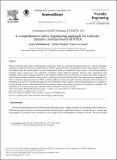A Comprehensive Safety Engineering Approach for Software-Intensive Systems Based on STPA
Author(s)
Abdulkhaleq, Asim; Wagner, Stefan; Leveson, Nancy G
DownloadLeveson_A comprehensive.pdf (342.4Kb)
PUBLISHER_CC
Publisher with Creative Commons License
Creative Commons Attribution
Terms of use
Metadata
Show full item recordAbstract
Formal verification and testing are complementary approaches which are used in the development process to verify the functional correctness of software. However, the correctness of software cannot ensure the safe operation of safety-critical software systems. The software must be verified against its safety requirements which are identified by safety analysis, to ensure that potential hazardous causes cannot occur. The complexity of software makes defining appropriate software safety requirements with traditional safety analysis techniques difficult. STPA (Systems-Theoretic Processes Analysis) is a unique safety analysis approach that has been developed to identify system hazards, including the software-related hazards. This paper presents a comprehensive safety engineering approach based on STPA, including software testing and model checking approaches for the purpose of developing safe software. The proposed approach can be embedded within a defined software engineering process or applied to existing software systems, allow software and safety engineers integrate the analysis of software risks with their verification. The application of the proposed approach is illustrated with an automotive software controller.
Date issued
2015-12Department
Massachusetts Institute of Technology. Department of Aeronautics and AstronauticsJournal
Procedia Engineering
Publisher
Elsevier
Citation
Abdulkhaleq, Asim, Stefan Wagner, and Nancy Leveson. “A Comprehensive Safety Engineering Approach for Software-Intensive Systems Based on STPA.” Procedia Engineering 128 (2015): 2–11.
Version: Final published version
ISSN
1877-7058